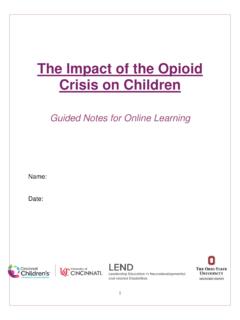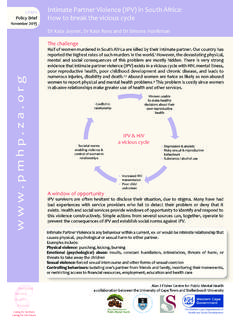Transcription of Working parents to prevent neglect - Children’s charities
1 No. 5. Policy and practice briefing I think PACT is a good place where you can bond with your child. It helps you build your confidence for the future with your child when you move.'. Working with parents to prevent neglect Supporting young women aged 16-24 years and their children from birth to 3 years Benny McDaniel with Margaret Kelly No. 5 Working with parents to Policy and prevent neglect practice briefing Supporting young women aged 16-24 years and their children from birth to 3 years Barnardo's PACT health care, adequate supervision, custody, a stable, safe and clean home, Barnardo's Parent and Children Together personal hygiene, adequate nutrition (PACT) offers accommodation and and education (Dubowitz et al 1993). assessment, with support 24 hours a day, to young women aged 16 to 24 years failure to provide adequate clothing and their children aged 3 years and under. (Nelson et al 1993). Many mothers have been in care and adults refusing to meet family needs, have very limited social networks.
2 Or allowing unsafe child behaviour to The service provided is intensive and is occur, for example not controlling a followed by an individually tailored child's access to drugs or alcohol. package of aftercare support to enable parents lacking knowledge of parents to settle back into the community. childcare (Wolfe, 1988). adults displaying a disregard for a Why does neglect happen? Those parents who are separated from child's safety, for example driving Many factors have been associated with their children are also offered support while intoxicated, inattention to the neglect including: having very young when they move from the project. child's emotional needs or exposure children, maternal depression, learning PACT is the only resource in Northern to domestic violence (Gaudin, 1993). difficulties, poverty, social isolation, Ireland offering such high level support deficiencies in child management skills, and receives referrals from across all In Northern Ireland, 47 per cent of all substance abuse and child factors such Trust areas.
3 The demand for the service children on the Child Protection as low birth weight and prematurity exceeds the number of placements Register are registered under the (Corby, 1993; Olds, 1997; Roberts, available. In 2000/01, it received 69 category of neglect ' (DHSSPS, 2003). 1988). As these characteristics are also referrals and offered 18 placements; in present in families who do not neglect Percentage of children registered 2001/02, 54 referrals and offered 19 their children, they cannot be seen as under neglect ' category as % of all placements; in 2002/03, 50 referrals and direct causes of neglect . registrations during year ended 31st offered 16 placements and in 2003/04, March Young lone parents or those with 70 referrals and offered 18 placements. learning difficulties are more likely to be 98/99 99/00 00/01. affected. The quality of childcare needs About this briefing Eastern Board to be explored within the environment Few studies offer evidence on interventions Northern Board parents live in, rather than seeing specifically addressing neglect .
4 This briefing neglect as an inevitable consequence of Southern Board highlights neglect issues, research and having learning difficulties or being a interventions, and concludes with Western Board young lone parent. recommendations to help others looking to Northern develop their own policies and services. Ireland total neglect and poverty England Northern Ireland has higher rates of What is neglect ? poverty than either Britain or the South In spite of the high number of neglect of Ireland (Hillyard et al 2003), with neglect can include: cases, neglect has received less research 148,900 children in Northern Ireland failure, delay or refusal to provide: attention than other forms of living in poor households. This adequate physical and/or mental maltreatment. Quotes from some of the young The staff are always around if you need to talk to them and will always give sensible advice even if it's not what you want mothers to hear.
5 '. I enjoyed my stay at PACT. It learned me a lot of things and helped me to look after my son better.' On the assessment process: I think PACT is a good opportunity for people to sort out things I think it's good, it's brilliant because you know what you need to in their lives.' checklists show you how to do things and you can check if PACT helped me get confidence back with Working with you're doing them right.'. children and trusting social services.'. represents per cent of all children be more likely if characteristics, already aged 15 or under living in households described, are present in a family already below the poverty threshold (Hillyard et under pressure (Roberts, 1988; Iwaniec, al 2003). In some areas, for example 1995; Dubowitz, 1999). Age and gender North and West Belfast, this figure rises are also linked to vulnerability children as high as 47 per cent of children are at more risk of neglect during their (DHSSPS, 2003).
6 In the short term, first year of life. Official statistics of children poverty can result in inadequate diets, on the Child Protection Register in poor health and debt. Longer term England suggest that boys are marginally effects include lower educational more at risk of both physical abuse and achievements, an increased risk of serious neglect than females (Corby, 1993). illness and a greater risk of offending (Holman, 1994; Roberts, 1997). What harm does peers. Neglected children are likely to Not all parents living in these experience global developmental delay, circumstances neglect their children. It is neglect do? particularly in the areas of language important to consider the personal as Children at different stages have and social skills (Hobbs & Wynne, well as wider social factors in different needs. In addition to the 2002). attempting to establish causes of neglect obvious physical risks, neglect has an It is the cumulative effects of failure (Stevenson, 1992; Gough, 1994).
7 Adverse effect on children's psychological to care for a child which make it and emotional well-being. Neglected significant and harmful to the child children are likely to experience Children cognitive delay, have low self esteem, (Bridge, 1995). The potential harm to the child also needs to be Children may be more vulnerable to are passive and withdrawn and have considered children may die as a abuse or neglect because of a attachment problems (Crittenden, 1988;. result of a single incidence of neglect , combination of factors including Parton, 1995; Erikson & Egeland, 1996). for example a young child left prematurity, illness, disability, or being unsupervised in the bath. unwanted. The presence of one risk factor increases the likelihood of others Physical and (Newman, 2002). Abuse or neglect may developmental effects Accidental injury neglect , depending on the level of Accidental childhood injury has been severity, is likely to have some found to be more likely in areas of immediate effects on the child's high social deprivation, and death due physical health, for example: repeated to childhood injury is up to five times accidents from lack of supervision, more likely in comparison to other repeated infections due to unhygienic areas (NISRA, 2000; Roberts & Power, living conditions and preventable illness 1996).
8 This is not necessarily because such as severe nappy rash that has not parents living in poverty lack awareness received medical attention. A of potential risks to their children, they neglected child may be viewed as may not be able to afford the essential unattractive because they are unkempt safety equipment (Woods et al 1994). or dirty, which can lead to rejection by As one mother said: Because I do not have safety equipment that does not Research The emphasis on evaluation allows mean I need to be educated in the fact Working methods to be adapted if that such equipment exists. I simply do The vast majority of the children who they are not effective, rather than not have the money to purchase it.' live in PACT are on the Child assuming the parent is at fault. (Rice et al 1994, ). Protection Register under the category of neglect '. A range of theories have Intervention builds on existing skills been used to inform work in the or develops new ones, rather than Emotional and service, offering explanations for focusing on any negative attributes of mothers.
9 Psychological effects behaviour but no directions for treatment. Behavioural interventions PACT decided to undertake research Emotional neglect has a negative are the exception to this, offering clear to assess the impact and effectiveness impact on children's psychological Working methods. of these interventions. development and has been found to be the most serious form of Behavioural social work methods maltreatment in terms of long-term introduced to the service six years ago Research aims consequences. Children have been were well received by staff and To develop and evaluate behavioural found to have attachment problems, mothers for a number of reasons. interventions to prevent child displaying anger, non-compliance, lack They promote service user neglect for children under 4 years. of persistence and little positive affect' involvement. (Erickson & Egeland, 1996, ). To enable parents to develop Expectations of parents are clearly childcare skills in a way that is Difficulties experienced may include outlined and progress made is sensitive to their child.
10 Low self-esteem, difficulty in trusting evident. others, poor school performance, and To adapt models developed in Emphasis on positive reinforcement Canada and the USA for use with problems in interacting with peers due recognises mothers' strengths and young parents in Northern Ireland. to difficulties in emotional and physical builds on these. development (Parton, 1995). Crittenden (1988) found that neglected children were likely to be very passive, disorganised, easily Summary of results not prevent mothers from caring for their children. Three mothers with distracted and to have learned to Intervention was effective when learning difficulties were assessed using ignore adults. Dubowitz et al (1993) mother's difficulties were caused by a the same standard as others, but some reported increased negativity and skills deficit for the specific task. For Working methods were adapted. These unhappiness in neglected children example, most mothers learned to mothers responded well to when compared to children who have bath their babies after one session.
















